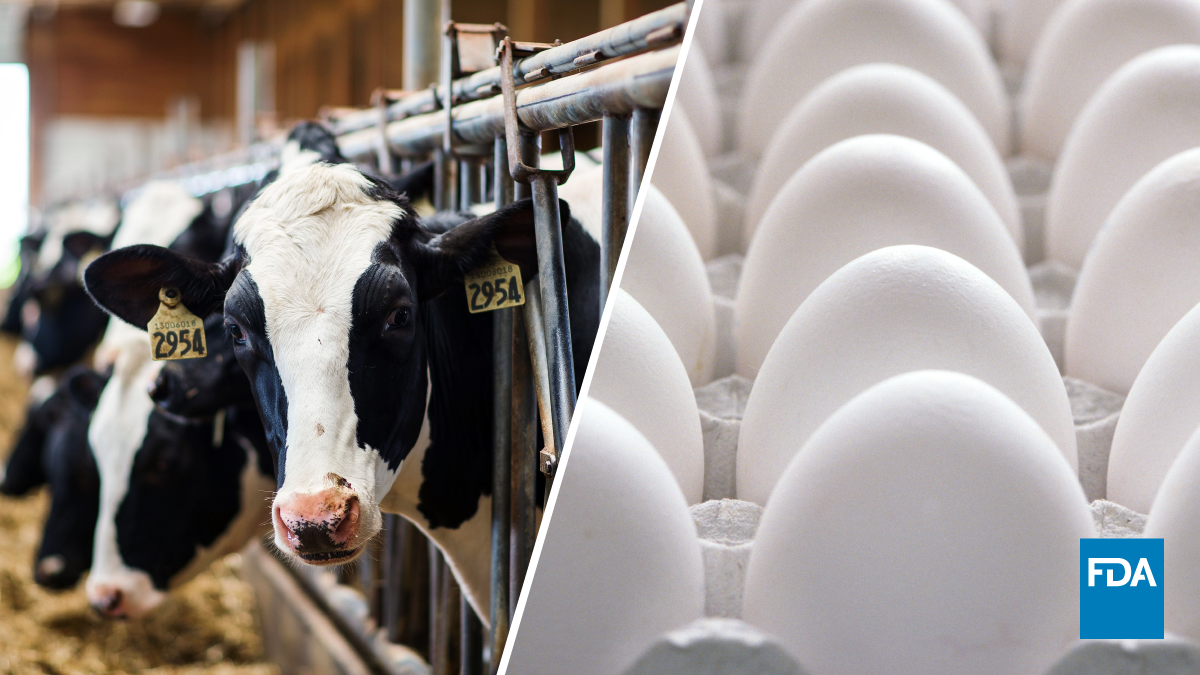Investigation of Avian Influenza A (H5N1) Virus in Dairy Cattle
The U.S. Department of Agriculture (USDA), the U.S. Food and Drug Administration (FDA), and the Centers for Disease Control and Prevention (CDC), along with state partners, continue to investigate an outbreak of Avian Influenza A (H5N1) impacting poultry, dairy cows, and people in multiple states.
The responsibility of the FDA is to protect the public health by ensuring the safety of the milk, dairy products, and animal feed supply. The U.S. Department of Agriculture’s Animal and Plant Health Inspection Service is leading the response from the animal health perspective while coordinating closely with the FDA and with the Centers for Disease Control and Prevention.
Status of the Milk SupplyWhat's New
FDA H5N1 Communications | Research & Studies
Resources for Producers | Resources for Consumers
Additional Information
Status of the Milk Supply
After the first detection of HPAI H5N1 in dairy cattle in March 2024, the FDA has engaged in research and other efforts with industry, federal, and state partners to ensure the continued effectiveness of the federal-state milk safety system.
Nearly all (99%) of the commercial milk supply that is produced on dairy farms in the US comes from farms that participate in the Grade A Milk Safety Program and follow the Pasteurized Milk Ordinance (PMO), which includes controls that help ensure the safety of dairy products. Pasteurization and diversion or destruction of abnormal milk are two important measures that are part of the federal-state milk safety system.
The process of pasteurization has helped to ensure the health of the American public for more than 100 years. Pasteurization kills harmful bacteria and viruses by heating milk to a specific temperature over time. Even if the virus is detected in raw milk, the current pasteurization process (HTST – High Temperature, Short Time) will inactivate the virus.
CDC Surveillance
What's New
December 30, 2024
On December 23, 2024, the U.S. Food and Drug Administration (FDA) began a domestic sampling assignment to collect and test aged raw cow’s milk cheese for Highly Pathogenic Avian Influenza (H5N1). Research & Studies for additional information.
FDA H5N1 Communications
9/30/2024 - Letters to Dairy Processing and Retail Industries
9/18/2024 - Announcement of the Animal and Veterinary Innovation Centers
6/6/2024 - Letter Regarding HPAI and Intrastate Raw Milk
5/10/2024 - Investigation Update
Research & Studies
12/23/2024 – Raw Cow’s Milk Cheese Sampling Survey Issued
10/3/2024 - Silo Study
9/26/2024 - Research Agenda Update
8/13/2024 - Second Retail Sample Survey Results
6/28/2024 - Study on Inactivation of HPAIV by Continuous Flow Pasteurization

6/25/2024 - FDA Research Agenda
5/10/2024 - First Retail Sample Survey Results (Update 4)
5/1/2024 - First Retail Sample Survey Results (Update 3)
4/26/2024 - First Retail Sample Survey Results (Update 2)
4/25/2024 - First Retail Sample Survey Results (Update 1)
Data Considerations
Resources for Producers
Resources for Consumers
Additional Information
- Content current as of:
12/30/2024
The U.S. Department of Agriculture (USDA), the U.S. Food and Drug Administration (FDA), and the Centers for Disease Control and Prevention (CDC), along with state partners, continue to investigate an outbreak of Avian Influenza A (H5N1) impacting poultry, dairy cows, and people in multiple states.
The responsibility of the FDA is to protect the public health by ensuring the safety of the milk, dairy products, and animal feed supply. The U.S. Department of Agriculture’s Animal and Plant Health Inspection Service is leading the response from the animal health perspective while coordinating closely with the FDA and with the Centers for Disease Control and Prevention.
Status of the Milk SupplyWhat's New
FDA H5N1 Communications | Research & Studies
Resources for Producers | Resources for Consumers
Additional Information
Status of the Milk Supply
After the first detection of HPAI H5N1 in dairy cattle in March 2024, the FDA has engaged in research and other efforts with industry, federal, and state partners to ensure the continued effectiveness of the federal-state milk safety system.
Nearly all (99%) of the commercial milk supply that is produced on dairy farms in the US comes from farms that participate in the Grade A Milk Safety Program and follow the Pasteurized Milk Ordinance (PMO), which includes controls that help ensure the safety of dairy products. Pasteurization and diversion or destruction of abnormal milk are two important measures that are part of the federal-state milk safety system.
The process of pasteurization has helped to ensure the health of the American public for more than 100 years. Pasteurization kills harmful bacteria and viruses by heating milk to a specific temperature over time. Even if the virus is detected in raw milk, the current pasteurization process (HTST – High Temperature, Short Time) will inactivate the virus.
CDC Surveillance
What's New
December 30, 2024
On December 23, 2024, the U.S. Food and Drug Administration (FDA) began a domestic sampling assignment to collect and test aged raw cow’s milk cheese for Highly Pathogenic Avian Influenza (H5N1). Research & Studies for additional information.
FDA H5N1 Communications
9/30/2024 - Letters to Dairy Processing and Retail Industries
9/18/2024 - Announcement of the Animal and Veterinary Innovation Centers
6/6/2024 - Letter Regarding HPAI and Intrastate Raw Milk
5/10/2024 - Investigation Update
Research & Studies
12/23/2024 – Raw Cow’s Milk Cheese Sampling Survey Issued
10/3/2024 - Silo Study
9/26/2024 - Research Agenda Update
8/13/2024 - Second Retail Sample Survey Results

6/25/2024 - FDA Research Agenda
5/10/2024 - First Retail Sample Survey Results (Update 4)
5/1/2024 - First Retail Sample Survey Results (Update 3)
4/26/2024 - First Retail Sample Survey Results (Update 2)
4/25/2024 - First Retail Sample Survey Results (Update 1)
Data Considerations
Resources for Producers
- HPAI in Livestock (USDA)
- Dear Veterinarian Letter Regarding Use of Aspirin Products in Lactating Dairy Cattle (FDA)
Resources for Consumers
- H5 Bird Flu: Current Situation (CDC)
- How CDC is monitoring influenza data among people to better understand the current avian influenza A (H5N1) situation (CDC)
Additional Information
- Questions and Answers Regarding the Safety of Eggs During Highly Pathogenic Avian Influenza Outbreaks
- Influenza Diagnostic Tests
